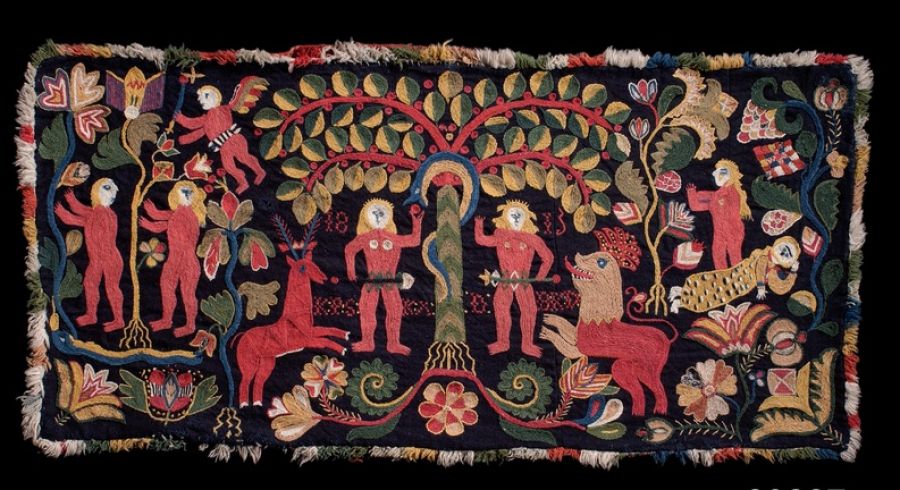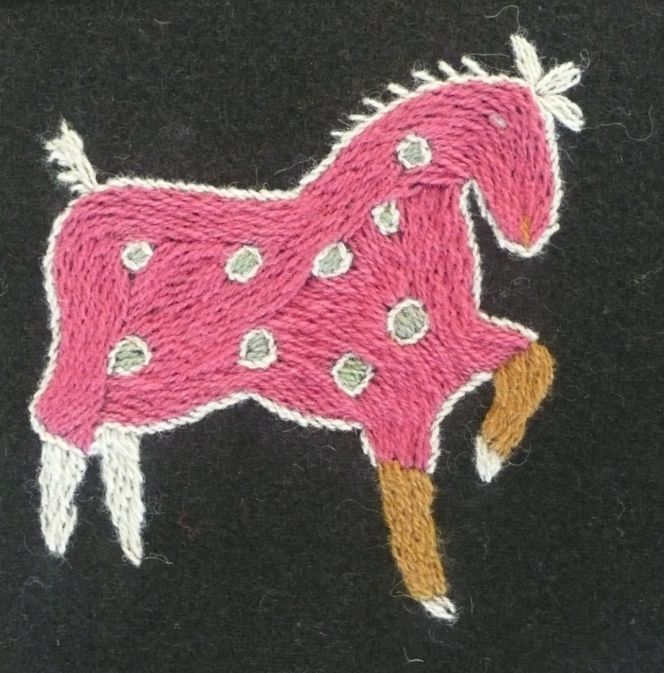ikfoundation.org
The IK Foundation
Promoting Natural & Cultural History
Since 1988


HISTORICAL REPRODUCTIONS
– Woollen Embroidery
Early 19th century woollen embroidery from southernmost Sweden was my second attempt at reproducing historical stitching. These well-crafted embroideries, with their rich variation of patterns, originate from long-lived traditions – often also mirrored in the tapestry weaving in corresponding geographical areas – developed into designs and individual motifs inherited from mother to daughter. The aim of this essay is to give a brief historical introduction of the cushions and bedcovers together with an explanation of used materials and stitching.
 This skilfully made travel cushion in woollen embroidery is preserved in several similar examples from early 19th century and is sewn with chain, stem, satin stitching and knots, added with an embellishing “kavelfrans” (napped edgings). Marking in cross stitch ‘KPS KAD BKD 1813’. From: Hötofta, Oxie district, Skåne, Sweden. (Courtesy of: Nordic Museum, Stockholm, NM.0020227, & historical facts from catalogue card. Creative Commons).
This skilfully made travel cushion in woollen embroidery is preserved in several similar examples from early 19th century and is sewn with chain, stem, satin stitching and knots, added with an embellishing “kavelfrans” (napped edgings). Marking in cross stitch ‘KPS KAD BKD 1813’. From: Hötofta, Oxie district, Skåne, Sweden. (Courtesy of: Nordic Museum, Stockholm, NM.0020227, & historical facts from catalogue card. Creative Commons).Cushions and bedcovers of this design/technique were primarily embroidered in wealthy farmers’ homes from c. 1750s-1830s, where the embroideries were an important part of the young woman’s dowry, either made by herself, her mother or other female relatives. The style of the patterns was of a domestic character stitched with woollen yarn on woollen cloth. Still, the tradition of the designs was, on the other hand, rooted in earlier centuries’, often inspired by class or bourgeois silk satin stitched embroideries on home textile furnishing and clothing.
![The same woollen embroidery is also used for one of the Nordic Museum’s postcards. This particular depiction is taken from an early 20th century catalogue card showing the object’s historical provenience and a beautifully made watercolour by Emelie von Walterstorff. [Photo Nordiska Museet]: postcard purchased at the Nordic Museum in 2013.](https://www.ikfoundation.org/uploads/image/yllebroderi-2-jpg-664x936.jpg) The same woollen embroidery is also used for one of the Nordic Museum’s postcards. This particular depiction is taken from an early 20th century catalogue card showing the object’s historical provenience and a beautifully made watercolour by Emelie von Walterstorff. [Photo Nordiska Museet]: postcard purchased at the Nordic Museum in 2013.
The same woollen embroidery is also used for one of the Nordic Museum’s postcards. This particular depiction is taken from an early 20th century catalogue card showing the object’s historical provenience and a beautifully made watercolour by Emelie von Walterstorff. [Photo Nordiska Museet]: postcard purchased at the Nordic Museum in 2013.Several hundred of these beautiful woollen embroideries are preserved today in museum collections and private homes, once used as cushions to sit on, travel cushions or decorative bedcovers. The embroideries have been described in many Swedish books/articles through the years, but Ernst Fischer was the textile researcher who made the most comprehensive historical observations and writings on the subject (published in 1971, in Swedish). He foremost described: the embroiderers, the history of the patterns, materials and stitching, how the motifs were drawn/copied and transferred to the fabric, signing and dating, most used colours, the significance of archive studies, preserved objects, embroidery in various classes of society together with detailed descriptions of more than 50 pattern combinations – as biblical figures, unicorns, elephants, horses, bridal couples, parrots, flowers, stars, garlands and geometrical designs in a myriad of combinations.
 Historical reproduction of woollen embroidery, detail from bedcover (1820) Ilstorp parish, Färs district, Skåne, Sweden. Photo and embroidery (1983): Viveka Hansen.
Historical reproduction of woollen embroidery, detail from bedcover (1820) Ilstorp parish, Färs district, Skåne, Sweden. Photo and embroidery (1983): Viveka Hansen.For the attempt to copy the embroidery type, a detail from the so-called “Ilstorpstäcket” (the bedcover from Ilstorp) signed ‘SPD 1820’ was chosen – by Fischer named as ‘the Masterpiece of Embroidery in Art from Skåne’ – a bridal bedcover whose various designs can be found both before and after this date. The pictured horse (14×13 cm) is mainly done with long and short satin stitching; that is to say, the motif on the front of the embroidery is covered with various lengths of satin stitches, while the stitching on the back is made as invisible as possible. This embroidery technique was often preferred in the 18th- and early 19th centuries, when most of the hand-spun and naturally dyed woollen yarn in red, blue, green, yellow and brown decorated the front. While as little yarn as necessary would be wasted on the back, which was not for display and, above all, covered with a lining or backing fabric of simpler/plainer design. Even if this type of embroidery was dominated by long and short satin stitching, ordinary satin stitch, knots, various stem stitching, chain-, feather-, fishbone- and interlacing stitches were often added. These stitches were often further personalised by the embroiderer’s skilled needle.
-664x431.jpg) The reproduction was made with five colours of 2-ply woollen yarn in long and short satin stitching added with stem stitches on brownish black broad cloth. Photo: Viveka Hansen.
The reproduction was made with five colours of 2-ply woollen yarn in long and short satin stitching added with stem stitches on brownish black broad cloth. Photo: Viveka Hansen.Sources:
- Fischer, Ernst, Skånska Yllebroderier i fria sömsätt, Malmö Museum Year Book 1971.
- Hansen, Viveka (Historical Reproduction/embroidery).
- DigitaltMuseum, Online (numerous examples of “yllebroderi” woollen embroideries kept in Swedish museums).
Essays
The iTEXTILIS is a division of The IK Workshop Society – a global and unique forum for all those interested in Natural & Cultural History from a textile Perspective.
Open Access essays, licensed under Creative Commons and freely accessible, by Textile historian Viveka Hansen, aim to integrate her current research, printed monographs, and earlier projects dating back to the late 1980s. Some essays feature rare archive material originally published in other languages, now available in English for the first time, revealing aspects of history that were previously little known outside northern European countries. Her work also explores various topics, including the textile trade, material culture, cloth manufacturing, fashion, natural dyeing, and the intriguing world of early travelling naturalists – such as the "Linnaean network" – viewed through a global historical lens.
For regular updates and to fully utilise iTEXTILIS' features, we recommend subscribing to our newsletter, iMESSENGER.
been copied to your clipboard




– a truly European organisation since 1988
Legal issues | Forget me | and much more...
You are welcome to use the information and knowledge from
The IK Workshop Society, as long as you follow a few simple rules.
LEARN MORE & I AGREE







